
|
|

January 30, 2009
TV at the Empire State Building
So here we are at a most exciting moment in broadcast history, just a few weeks away from the end of full-power analog TV broadcasting in the US, unless, of course, the new Congress changes the date. Until they do that, though, we'll continue to devote the next few weeks of Site of the Week - from now until (maybe) transition week, February 17, 2009 - to a look back at some of the more significant sites in Northeast analog TV history. This week, we bring together several visits to Market Number One, as we peek inside the transmitter rooms of the Empire State Building...)
There is no single site in the U.S. with more continuous television history than the Empire State Building. Almost from the moment it was completed in 1931, it has been home to television transmitters, antennas and even studios. And when analog television breathes its last one day soon, only Empire will be able to say it was there at the beginning and at the end.
We've been privileged, over the course of nearly a decade of visits to the building, to see many of the TV transmitter facilities here (as well as nearly all the FMs), and in honor of Empire's long and wonderful TV history, we're pleased to be able to give you a peek, too...
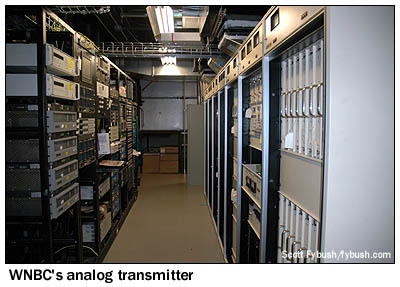 |
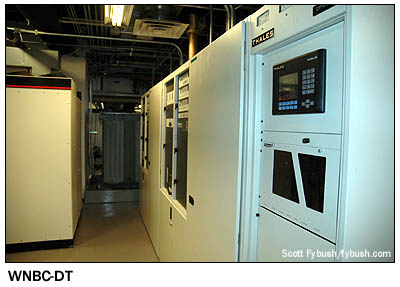 |
It's only fitting that we start at the descendant of the first TV station to call Empire home. NBC quickly sensed the promise of a spot a quarter-mile in the sky for testing and development of early television, and it signed a contract with Empire for exclusive broadcast use of the building's peak - and for the entire 85th floor, just under the main outdoor observation deck. W2XF/W2XK, the experimental NBC station later known as W2XBS, began its transmissions from Empire on December 22, 1931, and it was from the 85th floor transmitter room that the station became the first commercial TV station in America as WNBT on July 1, 1941.
WNBT later became WRCA-TV and then WNBC-TV, remaining at Empire even as its exclusivity deal with the city's tallest building ended. By the mid-fifties, all of New York's TV stations transmitted from Empire, and two decades later all the VHF signals, as well as a few UHFs, moved south to the new World Trade Center.
It wasn't the end of TV at Empire, though - NBC's old space on 85 was divided up, with NBC retaining two small rooms for ENG and WNBC-FM and two UHF stations, WXTV 41 and WWHT 68, carving out new transmitter rooms from much of the rest of Channel 4's old area.
And then, of course, came 9/11 - and a sudden need for lots of new TV transmitter space for all those stations that had been at the Trade Center. We chronicled the immediate aftermath in our "9/11 Plus One" article back in 2002; now we get to see some of the results.
By the time WNBC came back to Empire, it was in an area that had not previously been home to transmitters. The 78th and 79th floors had long been office space, and there were still some offices on 78 when we visited in 2006 - but there was also an unmarked door down a hallway that led into WNBC's new rooms. One, a storage area, held some items that had been upstairs on 85, including a blueprint of that floor in its days as NBC's TV studio/transmitter/lab facility from the thirties; the other is home to the Larcan VHF transmitter for analog channel 4 and the Thales UHF transmitter for digital 28.
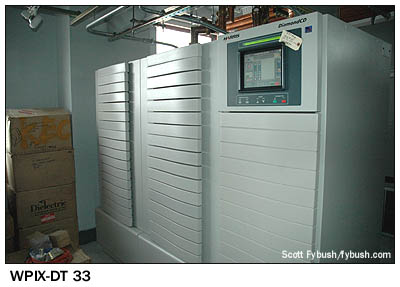 |
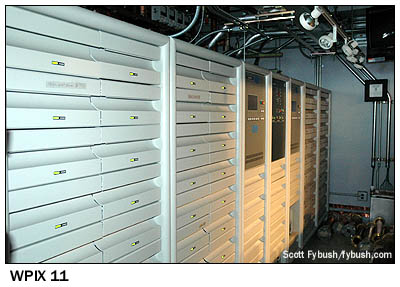 |
We've never made it inside several other TV rooms here - WCBS-TV (Channel 2) is, famously, still in its original space on the 81st floor, a fortunate result (or so the story goes) of a CBS employee accidentally renewing the lease at Empire after the new site at the Trade Center was completed. Because WCBS retained backup facilities at Empire, it was able to stay on the air after both the 1993 bombing and the 2001 destruction of the Trade Center, and we hope someday to see that room.
We'd also very much love to see the rooms on the 82nd floor that are home to Fox's WNYW (Channel 5) and WWOR (Channel 9); WNYW had built its digital facility (on channel 44) here at Empire instead of at Trade, and it was able to get analog service on the air from Empire fairly quickly after 9/11 as well. Today, the WNYW and WNBC analog signals are diplexed into the antenna at the very top of the Empire mast; we're not sure what will replace that antenna after analog channels 4 and 5 fade away.
We haven't seen WABC-TV (Channel 7)'s current facilities, either - but we can offer some rare glimpses at the remaining two VHF stations up here:

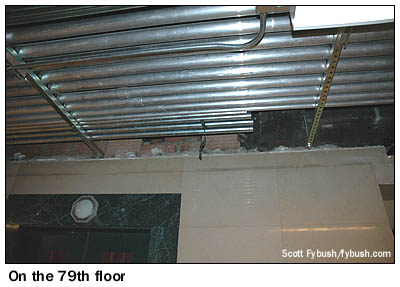 WPIX-TV
(Channel 11) has its new transmitter plant on the 79th floor,
where the conversion from offices to transmitter rooms inadvertently
exposed some Empire history that has nothing to do with broadcasting.
WPIX-TV
(Channel 11) has its new transmitter plant on the 79th floor,
where the conversion from offices to transmitter rooms inadvertently
exposed some Empire history that has nothing to do with broadcasting.
It was the 79th floor, after all, where that B-25 bomber that was lost in the fog crashed into the Empire State Building in July 1945, and while the visible parts of the building's interior were fairly quickly rebuilt, the scorch marks from the burning fuel can still be seen where the old false ceiling was removed to make room for transmission lines and new plumbing.
Behind yet another unmarked door, we enter WPIX, where an engineering shop looks out through big windows into a transmitter room that was relatively crowded when we visited in 2005. At the time, there were three transmitters on the air here - the Harris analog transmitter for channel 11, a Harris digital transmitter that had just been placed into service for WPIX-DT on channel 33, and another, smaller Harris digital transmitter behind those two, near a window, operating on channel 12. Channel 12? Yes - this was a temporary facility that operated for a couple of years while regular DTV service was restored, and I believe it was later used for testing distributed transmission system (DTS) on-channel DTV boosters around the city.
One channel up, and one floor below, another trip to New York brought us into the WNET (Channel 13) transmitter suite with some unusual company: WNET's now-retired president, Bill Baker, a noted ham radio operator as well as the longtime public face of Thirteen. We'd met him at a station event up in Rochester, and when we inquired about the possibility of a transmitter-room visit, he said, "I haven't been up there yet, either - mind if I come along?"
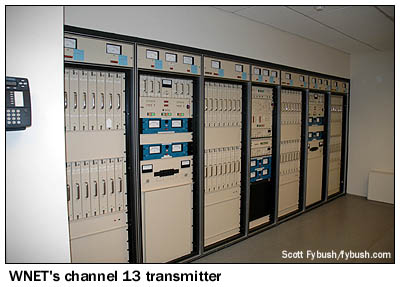 |
 |
We didn't, of course - and so we had Dr. Baker along when we toured the L-shaped corner suite that houses WNET's Larcan VHF transmitter, which will be retrofitted for its eventual DTV operation on channel 13. In the room behind the Larcan is the analog filtering that will be changed out for the DTV conversion - and the low-power transmitter that keeps WNET-DT chugging along on channel 61 until 13 becomes available. (There's also a nice office down the hall, with a window view that Dr. Baker immediately coveted...)
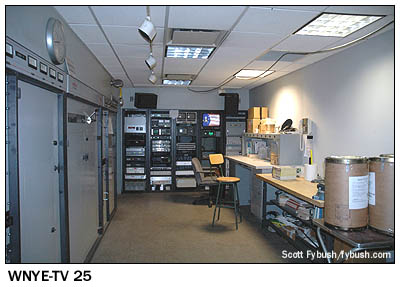 |
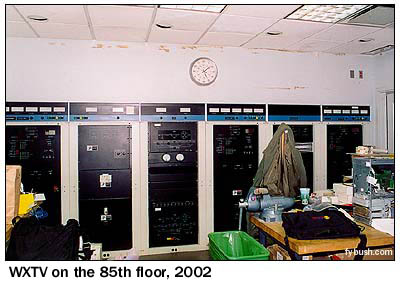 |
Back upstairs on the original transmitter floors (81, 82, 83 and 85), our tours over the years have brought us into many of the UHF stations' rooms. That's a rare Varian analog transmitter we saw in the compact space on 81 that belongs to WNYE-TV (Channel 25), the former city school station that's now "NYCtv." Its DTV counterpart on channel 24 was over at Brooklyn Tech at the time, so this room was analog-only when we visited, and that Varian would later spend much of 2008 off the air because of technical problems. With the end of analog TV, WNYE will leave Empire - the WNYE-DT transmitter is over at Four Times Square a few blocks away.
(Interesting trivia: when WNET first restored its signal from Empire after 9/11, it did so from a low-power transmitter on a pallet in the room behind the Varian.)
New York's Channel 31 started at Empire back in 1962 as an experimental operation, but lasted there as city-owned WNYC-TV for just a decade before moving to the Trade Center; it's since moved back as ion's WPXN-TV, and is somewhere on the lower floors in a room I've never seen.
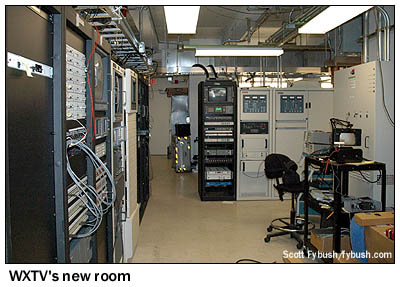 |
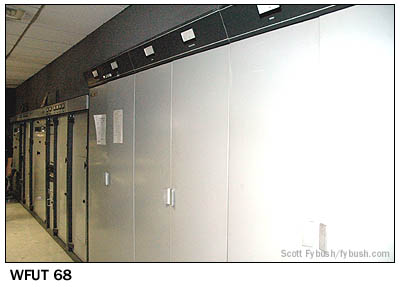 |
Channel 41, WXTV, was one of the UHF stations that remained at Empire during the Trade Center's existence, and it occupied an historic space indeed: the east side of the 85th floor, where NBC's early television studio and control room were located back in the thirties. That space survives now only in photos (so I'm glad I took one); by the time we got another look at WXTV, it was on one of the lower floors, with WXTV-DT (Channel 40) alongside. This photo, incidentally, I can date down to the hour - it was in this room that I saw the coverage (via Univision, of course) of George W. Bush's second inaugural, almost exactly four years ago.
Channel 47, WNJU, started on Empire back in the sixties as the market's first commercial UHF station, but moved to Trade and never came back in analog form. Its analog transmitter ended up in West Orange, New Jersey after 9/11, but WNJU-DT (Channel 36) holds a CP to return to Empire eventually.
Completing the roster of full-power TV at Empire was channel 68, which started out in West Orange as WBTB, then moved up to Empire in the seventies as subscription-television WWHT, later doing home shopping as WHSE and then Telefutura as WFUT.
Its transmitters - a Varian similar to WNYE's and a Pye, a brand common in England but highly unusual Stateside - occupied the west side of the 85th floor in a space that I think may once have been used by WABC-TV, and its antenna took the top spot on the mast, once home to WNBC.
When WNBC came back to that position, channel 68 ended up living out the rest of its analog days a few blocks away at Four Times Square; it holds a CP to return in digital form (as WFUT-DT on channel 30) to Empire, though its interim digital operation on channel 53 was also at Four Times Square.
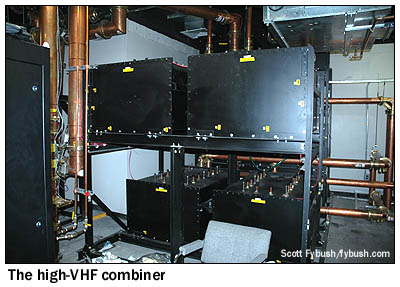 |
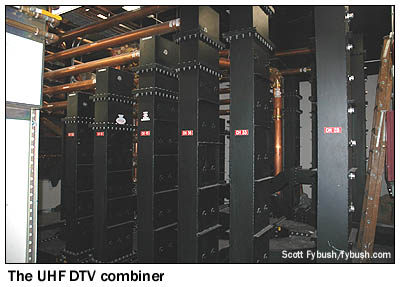 |
We complete our Empire State TV tour just down the hall from the old channel 68 space, and right next to the old channel 41 space. Rooms on the northwest corner of the 85th floor once occupied by NBC's ENG gear and by WCAA (105.9, which moved downstairs) have been reconfigured as TV combiner rooms, feeding new master antennas on the mast above.
There's a high-band VHF antenna that's shared by channels 7, 9, 11 and 13 - and which will continue to be fed by digital channels 7, 11 and 13 post-transition - and a UHF master antenna that looks like it should be in one of those AT&T commercials with all the signal bars. From left to right, it's being fed by 61 (WNET), 56 (WCBS), 45 (WABC), 38 (WWOR), 33 (WPIX) and 28 (WNBC); it will no doubt be massively reconfigured after the transition, when all but WNBC and WWOR end up on different channels.
Which is to say - the TV landscape on Empire will keep on changing, just as it has been doing ever since that first video signal went out from here almost 80 years ago.
- Previous Site of the Week: WRC, Washington, DC
- Next Week: TBA
- Site of the Week INDEX!
- How can you help support Site of the Week? Click here!
- Submit your suggestions for a future Site of the Week!
